Boston Police Department
 From Wikipedia - Reading time: 23 min
From Wikipedia - Reading time: 23 min
| Boston Police Department | |
|---|---|
 Patch of Boston Police Department | |
 Badge of Boston Police Department | |
 Flag of the City of Boston | |
| Abbreviation | BPD |
| Agency overview | |
| Formed | May 26, 1854 |
| Employees | 2,713 |
| Annual budget | $414 million (2020)[1] |
| Jurisdictional structure | |
| Operations jurisdiction | Massachusetts, U.S. |
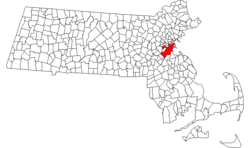 | |
| Map of Boston Police Department's jurisdiction | |
| Size | 89.6 square miles (232 km2) |
| Population | 617,594 (2010 census) |
| Legal jurisdiction | Boston, Massachusetts |
| General nature | |
| Operational structure | |
| Headquarters | Boston, Massachusetts |
| Police Officers | |
| Civilian members | 569 Civilian Members |
| Mayor of Boston responsible | |
| Agency executive |
|
| Facilities | |
| Patrol vehicles | Ford Expedition, Ford F250 |
| Patrol cars | Ford Crown Victoria Police Interceptor, Ford Explorer, Chevrolet Caprice PPV |
| K-9s | 33 |
| Website | |
| police | |



The Boston Police Department (BPD) is the primary law enforcement agency of Boston, Massachusetts, United States. Founded in 1854, the BPD is the oldest municipal police department in the United States.[4][5] It is also the 20th largest law enforcement agency in the country, with 2,713 sworn and unsworn personnel.[6]
History
[edit]Pre-incorporation (1635–1828)
[edit]Before the existence of a formal police department, the first night watch was established in Boston in 1635.[6] In 1703, pay in the sum of 35 shillings a month was set for members of the night watch. In 1796, the watch was reorganized, and the watchmen carried a badge of office, a rattle, and a six-foot pole, which was painted blue and white with a hook on one end and a bill on the other. The hook was used to grab fleeing criminals, and the rounded "bill" was used as a weapon. The rattle was a noise-making device used for calling for assistance.[7][8]
The Day Police, which had no connection to the night watch, was organized in 1838.[6] The Day Police operated under the city marshal and had six appointed officers. This organization would eventually lead to the establishment of the modern-day Boston Police Department.
Nineteenth century
[edit]In 1838, a bill passed in the General Court that allowed the city to appoint police officers, paving the way for the creation of a formal police department.[9] The Boston Police Department was formally founded in May 1854, at which point both the night watch and Day Police were disbanded. A 14-inch club replaced the old hook and bill, which had been in use for 154 years. At the time of its founding, the Boston Police constituted one of the first paid, professional police services in the United States. The department was closely organized and modeled after Sir Robert Peel's (London) Metropolitan Police Service.[8]
On November 3, 1851, the first Irish-born Boston Police officer, Bernard "Barney" McGinniskin, was appointed. His presence generated considerable controversy. The Boston Pilot wrote, "He is the first Irishman that ever carried the stick of a policeman anywhere in this country, and meetings, even Faneuil Hall meetings, have been held to protect against the appointment." At the time, the police salary of $2.00 a day for the morning and afternoon beat and $1.20 for the night watch was nearly twice as high as the wages of laborers. City Marshal Francis Tukey resisted mayor John Prescott Bigelow's appointment of McGinniskin, expressing the predominant anti-Irish sentiments in the city by arguing it was done at "the expense of an American." On January 5, 1852, shortly before the newly elected mayor Benjamin Seaver (who had been supported by Tukey) took office, Tukey fired McGinniskin without giving a reason. After criticism in the press, Seaver reinstated McGinniskin, who remained in the police until the 1854 anti-Irish groundswell of the Know Nothing/American Party movement, when in the words of the Boston Pilot, "Mr. McGinniskin was discharged from the Boston Police for no other reason than he was a Catholic and born in Ireland." McGinniskin became a United States inspector at the customhouse and died of rheumatism on March 2, 1868.[10] McGinniskin is buried in the St. Augustine Cemetery in South Boston.[8]
On October 18, 1857, at about 5:15 a.m., Boston Police Officer Ezekiel W. Hodsdon was patrolling the corner of Havre and Maverick Street in East Boston. Hodsdon attempted to arrest two suspects for a burglary. A struggle ensued, and one of the suspects was able to get behind Hodsdon and shoot him in the head. Hodsdon died about 10:00 A.M., becoming the first Boston police officer killed in the line of duty. He was 25 years old. The murderers fled. Thousands of people visited the station house to view the body. Hodsdon left behind his wife Lydia and infant son Ezekiel, who was born just 13 days prior to his death. He was buried in Woodlawn Cemetery in Everett, according to Boston Globe newspaper reports on October 19, 1857.[11] On October 18, 2007, a memorial was held in honor of Hodsdon on the corner of Havre and Maverick Streets in East Boston.[8] On July 14, 1863, Boston Mayor Frederic W. Lincoln Jr. (1858–1861 & 1863–1867) ordered all 330 officers in the Department to quell a draft riot among Irish Catholics attempting to raid Union armories in the North End.[12]
In 1871, the Boston Police Relief Association was founded. The purpose of the Boston Relief Association is intended to provide support and relief for officers of the Boston Police Department and their families. It was incorporated under the statutes of Massachusetts in 1876.[8]
The Boston Police Department appointed Horatio J. Homer, its first African American officer, on December 24, 1878. He was promoted to sergeant in 1895. Sgt. Homer retired on Jan 29, 1919, after 40 years of service. He and his wife, Lydia Spriggs Homer, are buried at Evergreen Cemetery in Brighton, MA.[13] On June 26, 2010, the Boston Police Department dedicated a gravestone in honor of Sgt. Homer's service.[8]
20th century
[edit]1910s
[edit]On September 9, 1919, when Police Commissioner Edwin Upton Curtis refused to allow the creation of a police union, 1,117 BPD officers went on strike. This signaled a dramatic shift in traditional labor relations and views on the part of the police, who were unhappy with stagnant wages and poor working conditions. The city soon fell into riots and public chaos as over three-fourths of the department was no longer enforcing public peace. Governor Calvin Coolidge intervened to quash further chaos. Coolidge announced that the police did not have the right to strike against the public safety and brought in the state national guard to restore order to Boston. The strike was broken, permanently, when Coolidge hired replacement police officers, many of whom were returning servicemen from World War I, and the former officers were refused re-entry into the department. Ironically, the new officers hired in the wake of the strike received higher salaries, more vacation days and city-provided uniforms, the very demands the original strikers were requesting. The BPD strike set a precedent for further movements to stymie police unionization around the country.[8]
Coolidge's intervention in the strike brought him national fame, which, in turn, led to his nomination as Harding's running mate for vice-president in the 1920 presidential election.
1920s
[edit]In 1921, Irene McAuliffe, daughter of the late Weston police chief and horse breeder Patrick McAuliffe, was among the first six female members of the Boston Police Department. An accomplished horsewoman, she was sworn in as a mounted officer of the Weston Police Department in 1913 during the town's bicentennial celebration. She joined the District of Columbia Police Department in 1920, and in 1921 she became a member of the Boston Police Department's Vice Squad.[8][14]
1930s
[edit]On May 29, 1930, Oliver Garrett was charged with 152 counts of conspiracy, extortion, and receiving gratuities for crimes allegedly committed as leader of BPD's liquor raiding unit during Prohibition.[15] Commissioner Herbert A. Wilson, who had conducted a secret investigation into Garrett two years earlier and had overrode his subordinates to grant Garrett a questionable disability pension, was removed from office by the Governor Frank G. Allen and the Massachusetts Governor's Council.[16][17][18][19] On May 7, 1931, Garrett pleaded to guilty and was sentenced to two years in the Deer Island House of Correction and fined $100.[20]
1960s
[edit]In 1965, the largest police union representing Boston police employees, the Boston Police Patrolmen's Association, was formed.
School desegregation busing crisis
[edit]In 1974 and 1975, the BPD was involved in maintaining order during the public disturbance over court-ordered busing, which was intended to racially desegregate Boston's public school system.[6][21] The protest of white citizens escalated into street battles in 1974, and in 1975 uniformed BPD officers were stationed inside South Boston High School, Charlestown High School and other Boston public schools.[21]
1980s
[edit]1982 Boston arson spree
[edit]Between 1982 and 1984, an arson ring that included BPD officers and allies set fire to 264 buildings. The ring opposed Proposition 2½, which reduced the funds that Massachusetts municipalities could raise through property taxes and led to cuts in fire departments and police agencies. Through committing arson, the ring hoped to cause social disorder to make the case for the necessity of firefighters and police.[22]
Charles Stuart murder investigation
[edit]In 1989, Charles Stuart killed his wife and accused an unknown black man for the murder. BPD proceeded to conduct a manhunt targeting young black men, indiscriminately using stop and frisk tactics, especially in neighborhoods of Mission Hill and Roxbury. Some residents compared the response to living in a war zone and the response is said to have contributed to distrust between black communities and BPD for decades following.[23]
1990s
[edit]Federal fingerprinting coordination
[edit]On August 23, 1995, the BPD became the first police agency to send fingerprint images to the FBI electronically using the newly created EFIPS (now IAFIS) system. The first set of fingerprints were for a suspect arrested for armed robbery. Within hours of the receipt of the fingerprints, the FBI determined that the suspect had a number of prior arrests, including one for assault with intent to kill.[24]
21st century
[edit]On December 31, 2006, 31 Boston Municipal Police Officers were allowed to transfer to the Boston Police. On January 1, 2007, the rest of the Munis were either laid off or transferred to the city's Municipal Protective Services, which provides security to the city's Property Management Department. There was no merger with the Boston Municipal Police.
The transfer of Munis was planned in mid-2006 by Mayor Thomas M. Menino. This plan was met with heavy protest from the Boston Police Patrolmen's Association (BPPA). The BPPA's argument was that the Municipal officers were not qualified to be Boston police officers due to lack of training, political patronage, nepotism, and the fact that the Munis were not civil service tested.[25]
2000s
[edit]2007 Boston Bomb Scare
[edit]On January 31, 2007, 911 callers mistakenly identified small electronic promotions found throughout Boston and the surrounding cities of Cambridge and Somerville as possible explosives. Upon investigation by Boston Police and other agencies,[26] the suspicious devices turned out to be battery-powered LED placards with an image of a cartoon character called a "mooninite" used in a guerrilla marketing campaign for Aqua Teen Hunger Force Colon Movie Film For Theaters, a film based on the animated television series Aqua Teen Hunger Force on Cartoon Network's late-night programming block Adult Swim.[26]
The BPD's handling of this incident has been criticized by some Boston residents and justified by others: One resident said that the police response was "silly and insane," and that "We’re the laughing stock."[27] Another resident said that the device "looked like a bomb. I picked it up, pulled the tape off it, and there were batteries, two on the top and three on the bottom."[26] The same devices had been distributed in nine other cities across the USA without provoking a similar reaction.[27] The United States Department of Homeland Security praised Boston authorities "for sharing their knowledge quickly with Washington officials and the public."[28]
2010s
[edit]Occupy Boston Movement
[edit]Beginning in September–October 2011, protesters assembled in Dewey Square as a show of solidarity with the Occupy Wall Street protest in New York. In the early hours of October 11, 2011, Boston Police and Transit Police moved into the protesters' secondary camp, arresting approximately 100 protesters.[29] Protesters reported numerous incidents of police brutality. Mayor Menino denied the reports and claimed that the protesters endangered public safety.[30]
In 2018, Mayor Marty Walsh announced that Boston Police Department would be adding five Americorps members as part of a partnership with the Police Assisted Addiction and Recovery Initiative.[1] The Americorps members were trained recovery coaches and helped the police refer individuals in the community into treatment and recovery for substance use disorder.[2]
Boston Marathon bombing
[edit]The BPD responded to the Boston Marathon bombing in 2013.[31]
2020s
[edit]2020 Black Lives Matter riots
[edit]During the 2020 George Floyd riots, the department came under scrutiny by elected officials for its usage of tear gas against civilians.[32] Demonstrations against police brutality began in the city in May 2020 and continued through June.[33]
Overtime fraud cases
[edit]In early September 2020, United States Attorney Andrew Lelling indicted nine former and current Boston police officers for allegedly collecting more than $200,000 in fraudulent overtime payments while working in the department’s evidence warehouse.[34]
In 2024, 7 Boston police officers were paid over $500,000, although there were no mentions of charges being filed.[35]
Alleged child rapist as union president
[edit]In April 2021, The Boston Globe reported that a 1995 internal investigation by the BPD concluded that Patrick M. Rose Sr., a BPD patrolman, had likely sexual assaulted a 12-year-old child. The BPD did not act on that finding. Instead, Rose kept his badge, served for another 21 years, and was elected president of the Boston Police Patrolmen's Association. He was ultimately arrested and on November 20, 2020, Rose was indicted in Suffolk Superior Court on thirty three counts related to sexual assault of children, including sixteen counts of child rape. During his time in the BPD, the department did nothing to limit his interactions with children, including allowing Rose to work on child sexual assault cases.[36]
Commissioner White termination
[edit]Following the abrupt resignation of commissioner William G. Gross at the end of January 2021, mayor Marty Walsh quickly named superintendent Dennis White to succeed Gross.[37] White was sworn in on February 1, 2021.[38] Two days later, White was placed on leave due to "the handling of a 1999 allegation of domestic violence" against White coming to light.[39] The city of Boston subsequently hired an independent attorney to conduct an investigation; meanwhile, Walsh resigned as mayor upon his confirmation as United States Secretary of Labor. Results of the investigation were released in mid-May,[40] followed by several legal actions by White's attorney seeking to block the city from terminating White.[41] Ultimately, acting mayor Kim Janey fired White on June 7, 2021.[42]
Departmental organization
[edit]This section needs additional citations for verification. (August 2009) |




The Boston Police Department has approximately 2,015 officers and 808 civilian personnel, with patrol services covering an area of 89.6 mi2 (232.1 km2) and a population of 617,594. Like all City of Boston departments, the BPD requires all employed officers hired since 1995 to live within Boston city-limits. The BPD is divided into three zones and 11 neighborhood districts spread across the city, with each zone supervised by a Deputy Superintendent and every district headed by a Captain.[8]
Ranks
[edit]The Boston Police rank structure is as follows:
| Title | Insignia | Notes |
|---|---|---|
| Commissioner (civilian) | The Commissioner is appointed by the Mayor of Boston. The Commissioner is the executive head of the department. | |
| Superintendent-in-Chief |  |
Superintendent-in-Chief is the highest-ranking police officer in the department. This position is not always filled. |
| Superintendent | Superintendents are typically in charge of a Bureau, or they can be the director of the academy | |
| Deputy Superintendent | Deputy Superintendents are typically second-in-command of a Bureau, or the deputy director of the academy | |
| Captain | Captains are typically commanders in charge of a district, a unit commander in academy, or service chief in the department administration and act as detective officers if needed | |
| Lieutenant | Lieutenants hold the function of second-in-command in a district, or Unit leader in a district, or service chief in the department administration, or instructor in the academy and can act as detective officers in the Department | |
| Sergeant/Sergeant Detective | Sergeants have the functions of district sergeant, or unit deputy chief in district or staff sergeant in the department administration, or instructor in the academy and are responsible for supporting detectives where needed | |
| Detective | Detective is a rank, guaranteed by a Legislative Act of 1986. They work in plainclothes and hold the function of an investigator. | |
| Police Officer | Police Officers are the first ranking officers. | |
| * Certain jobs within the department are designated as Detective Supervisor jobs (District Det. Supervisor, Sexual Assault Unit, Domestic Violence, etc.). Detective Supervisors earn their "rating" after serving a certain amount of time in said role and are referred to as their rank followed by "detective" (i.e. sergeant detective, lieutenant detective, etc.)[43] | * Deputy Superintendents and above serve at the pleasure of the Police Commissioner and in the case of the Commissioner, the Mayor. |
Leadership
[edit]


Dennis White was appointed as commissioner on February 1, 2021;[38] he was placed on leave on February 3, 2021.[39] Gregory P. Long has been the superintendent-in-chief since August 2018;[44] he was named acting commissioner upon White being placed on leave.[39]
Kathleen O'Toole was the first woman to serve as commissioner, from February 2004 through May 2006 when she left to take a new position as Chief Inspector of the Inspectorate of the Irish national police force, the Garda Síochána.[45]
Members of the Boston Police Commission
[edit]A three-person police commission (also called the police board) consisted of members nominated by the Governor of Massachusetts and approved by the Massachusetts Governor's Council. The commission was established in 1878 and abolished in 1906.
| Name | Term start | Term end |
|---|---|---|
| Henry S. Russell | July 8, 1878 | March 1, 1880 |
| Samual R. Spinney | July 8, 1878 | May 3, 1880 |
| James M. Bugbee | July 8, 1878 | May 5, 1879 |
| Henry Walker | May 5, 1879 | April 21, 1882 |
| Edward J. Jones | March 26, 1880 | April 21, 1882 |
| Thomas J. Gargan | May 3, 1880 | April 21, 1882 |
| Thomas L. Jerks | April 22, 1882 | July 23, 1885 |
| Nathaniel Wales | April 22, 1882 | July 7, 1885 |
| Benjamin D. Barley | April 22, 1882 | May 6, 1883 |
| Michael P. Curran | May 7, 1883 | July 23, 1885 |
| Albert T. Whiting | July 2, 1885 | May 6, 1895 |
| William H. Lee | July 23, 1885 | May 28, 1894 |
| William M. Osborne | July 23, 1885 | April 30, 1893 |
| Robert F. Clark | May 1, 1893 | May 4, 1903 |
| Augustus P. Martin | May 28, 1894 | May 1, 1899 |
| Charles P. Curtis Jr. | May 6, 1895 | May 1, 1905 |
| Harry F. Adams | May 1, 1899 | June 4, 1906[46] |
| William H. Emmons | May 5, 1903[47] | June 4, 1906[46] |
| Charles H. Cole | May 1, 1905[48] | June 4, 1906[46] |
List of Boston Police Commissioners
[edit]Boston's police commissioner was appointed by the Governor until 1962.[49] Edmund L. McNamara was the first commissioner to be appointed by the mayor of Boston, taking office in April 1962 via appointment by mayor John F. Collins.[50] Once appointed, a commissioner can only be removed from the position for cause until their term expires.[51] A commissioner may be appointed to a five-year term, or to serve the remainder of a predecessor's five-year term.[51]
Names in italics indicate a person served as acting (interim) commissioner only. Since 1985, several acting commissioners have been sworn as permanent. Numbering is per cited contemporary news reports and may include inconsistencies.
| No. | Name | Acting | Sworn / permanent | Ref. | |||
|---|---|---|---|---|---|---|---|
| Term start | Term end | Term start | Term end | ||||
| 1 |  |
Stephen O'Meara | June 4, 1906 | December 14, 1918 | |||
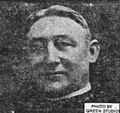 |
Michael H. Crowley | December 14, 1918 | December 30, 1918 | ||||
| 2 | 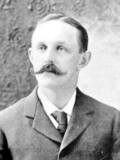 |
Edwin Upton Curtis | December 30, 1918 | March 28, 1922 | |||
 |
Michael H. Crowley | March 28, 1922 | April 3, 1922 | ||||
| 3 |  |
Herbert A. Wilson | April 3, 1922 | May 5, 1930 | |||
 |
Michael H. Crowley | May 5, 1930 | May 8, 1930 | ||||
| 4 | 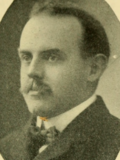 |
Eugene Hultman | May 8, 1930 | December 27, 1934 | |||
| 5 |  |
Joseph J. Leonard | December 27, 1934 | February 23, 1935 | |||
| 6 | Eugene M. McSweeney | February 23, 1935 | November 25, 1936 | ||||
| 7 | Joseph F. Timilty | November 25, 1936 (took office) June 5, 1943 (reinstated) |
March 27, 1943 (suspended) November 25, 1943 (term ended) |
||||
| Thomas S. J. Kavanagh | March 27, 1943 | June 5, 1943 | |||||
| 8 |  |
Thomas F. Sullivan | November 26, 1943 | August 27, 1957 | |||
| James F. Daley | August 27, 1957 | September 4, 1957 | |||||
| 9 |  |
Leo J. Sullivan | September 4, 1957 | March 15, 1962 | |||
| Francis J. Hennessy | March 15, 1962 | April 6, 1962 | |||||
| 10 |  |
Edmund L. McNamara | April 6, 1962 | May 31, 1972 | |||
| William J. Taylor | May 31, 1972 | November 1, 1972 | |||||
| 11 |  |
Robert diGrazia | November 1, 1972 | November 15, 1976 | |||
| 12 | Joseph M. Jordan | November 15, 1976 | January 31, 1985 | ||||
| 13 |  |
Francis Roache | February 1, 1985 | March 13, 1985 | March 13, 1985 | June 30, 1993 | |
| 14 |  |
William Bratton | June 30, 1993 | January 10, 1994 | |||
| 15 | Paul F. Evans | January 10, 1994 | February 14, 1994 | February 14, 1994 | November 14, 2003 | [52] | |
| James Hussey | November 14, 2003 | February 19, 2004 | |||||
| 16 | 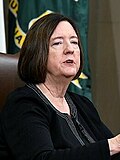 |
Kathleen O'Toole | February 19, 2004 | May 31, 2006 | [53] | ||
| Al Goslin | May 31, 2006 | December 5, 2006 | |||||
| 17 |  |
Ed Davis | December 5, 2006 | November 1, 2013 | [54] | ||
| 18 |  |
William B. Evans | November 1, 2013 | January 9, 2014 | January 9, 2014 | August 4, 2018 | [55] |
| 19 | 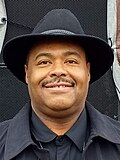 |
William G. Gross | August 4, 2018 | August 6, 2018 | August 6, 2018 | January 29, 2021 | [56] |
| 20 | Dennis White | January 29, 2021 | February 1, 2021 | February 1, 2021 | February 3, 2021 (suspended) June 7, 2021 (terminated) |
[57][39][58] | |
 |
Gregory Long | February 3, 2021 | August 15, 2022 | [39] | |||
| 21 |  |
Michael Cox | August 15, 2022 | incumbent | [59] | ||
Special operations unit
[edit]
The Boston Police Special Operations Unit is a specialized unit within the Boston Police Department responsible for combined duties involving Highway Patrol and traffic enforcement, crowd control, and special weapons and tactics (SWAT) services within the city.[60][61]
One unique feature of the unit is that the Special Operations Unit primarily relies on the use of Ford Crown Victoria Police Interceptors and Harley-Davidsons in their daily patrols. The use of motorcycles allows the unit to perform routine traffic enforcement; accompany parades, crowds, and visiting dignitaries; and to quickly travel to situations wherein the unit's SWAT skills are requested. Specialized trucks and support vehicles are also used to transport equipment and officers when needed.[citation needed]
The Canine unit with twenty-seven patrol/narcotics and EOD dogs, and the Bomb (EOD) Squad is also under the Special Operations Division.[citation needed]
Equipment
[edit]Transportation
[edit]The Boston Police uses the following vehicles.
- Ford Police Interceptor SUV – Current issue patrol car.
- Chevy Caprice Current issue patrol car.
- Chevy Impala Current issue patrol car.
- Chevy Tahoe PPV – Current issue patrol car.
- Ford Crown Victoria Police Interceptor – Mostly phased out as of July 2019. Occasionally seen on a detail, etc.
- Ford F-250 - Prisoner transport vehicle
- Ford Expedition
- Harley-Davidson
- HMMWV
Weapons
[edit]Boston police officers may carry "only weapons, magazines and ammunition authorized and issued by the Department", which "include, but are not limited to":[62]
- Benelli M3 SBS (12 gauge)
- Bushmaster XM-15 (.223 Remington)
- Glock Model 22[62] (.40 S&W)
- Glock Model 23[62] (.40 S&W)
- Glock Model 27[62] (.40 S&W)
- SIG Sauer GSR in .45 ACP[63][64]
- SIG Sauer P320 9×19mm: used by Boston Police Department Special Operations Unit only.
Demographics
[edit]- By gender
- Male: 84%
- Female: 16%[65]
- By race
- White: 65.5%
- African-American: 23.9%
- Hispanic: 8.3%
- Asian: 2.4%[66]
Fictional portrayals
[edit]The Boston Police Department has been portrayed in several prominent motion pictures including The Equalizer, Patriots Day, Gone Baby Gone, Mystic River, The Departed, Edge of Darkness, Blown Away, The Brink's Job, That's My Boy, R.I.P.D., The Heat, X2, What's The Worst That Could Happen?, The Boondock Saints, Spenser Confidential, Surrogates, and The Town. BPD is also featured in the television series City on a Hill, Spenser: For Hire, Rizzoli & Isles, Leverage, Crossing Jordan, Fringe, and the failed Katee Sackhoff/Goran Visnjic police show pilot Boston's Finest.
See also
[edit]References
[edit]- ^ "Fiscal Year 2020 Adopted Budget" (PDF). City of Boston. 2020. Archived (PDF) from the original on June 4, 2020. Retrieved June 4, 2020.
- ^ "Boston Police OT is spiking, a persistent challenge for an understaffed force". September 13, 2024.
- ^ "Hiring 'crisis' seen in Boston Police ranks; Council hearing takes up recruit problem | Dorchester Reporter".
- ^ Waxman, Olivia B. (May 29, 2017). "The Societal Changes That Created the American Police Officer" (Archived 2020-07-10 at the Wayback Machine). Time. May 18, 2017.
- ^ "The History of Policing in the United States, Part 1". June 25, 2013. Archived from the original on February 1, 2014. Retrieved May 13, 2018.
- ^ a b c d A Brief History of The B.P.D. (Archived 2012-03-04 at the Wayback Machine). City of Boston, Police Department (accessed 3 December 2009).
- ^ Taylor, J. "The Victorian Police Rattle Mystery" Archived 2010-02-18 at the Wayback Machine The Constabulary (2003)
- ^ a b c d e f g h i BPD Chronologist
- ^ "A Brief History of the B.P.D." City of Boston.gov. City of Boston. 2011. Archived from the original on March 4, 2012. Retrieved February 26, 2012.
- ^ Peter F. Stevens: The Hidden History of the Boston Irish p.42-45
- ^ "The Officer Down Memorial Page". Archived from the original on December 12, 2009. Retrieved December 8, 2009.
- ^ Tager, Jack (2001). Boston Riots: Three Centuries of Social Violence. Boston: Northeastern University Press. p. 136. ISBN 978-1555534615.
- ^ Information Taken from Boston Police Commissioner Order on January 29, 1919, online at the BPL.
- ^ Boston Police Archives & Commissioner Orders
- ^ "Garrett Leaves Cell Before 11". The Boston Daily Globe. May 30, 1930.
- ^ "Garrett Cleared By Wilson After Secret Probe in 1928". The Boston Daily Globe. March 13, 1930.
- ^ "Garrett No Longer Boston Policeman". The Boston Daily Globe. October 24, 1929.
- ^ "Wilson Quits Post as Split Develops". The Boston Daily Globe. May 6, 1930.
- ^ "Governor Removes Boston Police Head". The New York Times. May 6, 1930.
- ^ "Raider Shifts Plea Suddenly To Guilty". The Boston Daily Globe. May 8, 1931.
- ^ a b "Boston: Preparing for the Worst". Time. (September 15, 1975).
- ^ Sweeney, Emily (September 9, 2019). "New book 'Burn Boston Burn' looks at arson ring that set more than 200 fires in the 1980s". The Boston Globe. Archived from the original on July 16, 2020. Retrieved July 16, 2020.
- ^ Bernard, Diane (January 4, 2020). "'They were treated like animals': The murder and hoax that made Boston's black community a target 30 years ago". The Washington Post. Retrieved July 11, 2020.
- ^ 1995 Annual Report of the Attorney General of the United States: Chapter II - Supporting Law Enforcement in the Community
- ^ According to Pat Rose.37 Boston Municipal Officers don't qualify for merger Archived September 28, 2007, at the Wayback Machine
- ^ a b c Smalley, Suzanne; Mishra, Raja (February 1, 2007). "Froth, fear, and fury". The Boston Globe. Retrieved February 2, 2007.
- ^ a b Young Bostonians think city overreacted Archived 2023-05-11 at the Wayback Machine NBC News
- ^ "Arrest Made After 'Suspicious Packages' Paralyzed Boston as Part of Cartoon Network Marketing Campaign". Fox News. January 31, 2007.
- ^ Ryan, Andrew; et al. (October 11, 2011). "More than 100 arrested in Occupy Boston protests". Boston Globe. Archived from the original on October 11, 2011. Retrieved October 11, 2011.
- ^ "Menino Disputes Police Brutality Claims In 'Occupy Boston' Arrests « CBS Boston". Boston.cbslocal.com. October 11, 2011. Archived from the original on January 14, 2012. Retrieved February 17, 2012.
- ^ "Then-police commissioner on how security has changed since Boston Marathon bombings". April 12, 2023.
- ^ "An Effort to Curtail the Use of Tear Gas on Protesters Is Underway in Massachusetts". Boston. June 3, 2020. Retrieved June 8, 2020.
- ^ McDonald, Danny. "Throughout Mass., rallies continue to protest police brutality, systemic racism - The Boston Globe". BostonGlobe.com. Archived from the original on June 8, 2020. Retrieved June 8, 2020.
- ^ Ellement, John R. (September 2, 2020). "Nine former and current Boston police officers charged with overtime fraud, US Attorney Lelling says". The Boston Globe. Archived from the original on September 2, 2020. Retrieved September 2, 2020.
- ^ "7 Boston cops earned more than $500,000 last year". March 12, 2025.
- ^ "For years, the Boston Police kept a secret: the union president was an alleged child molester". Boston Globe. 2021. Archived from the original on April 11, 2021. Retrieved April 11, 2021.
- ^ "William Gross to Retire; Mayor Appoints Dennis White as 43rd Boston Police Commissioner". boston.gov (Press release). January 28, 2021. Retrieved January 28, 2021.
- ^ a b Gavin, Christopher (February 1, 2021). "Dennis White vows to see through reforms as Boston's police commissioner". Boston.com. Archived from the original on February 1, 2021. Retrieved February 1, 2021.
- ^ a b c d e Ryan, Andrew; Arnett, Dugan (February 3, 2021). "Walsh places new police commissioner on leave after past domestic violence allegation surfaces". The Boston Globe. Archived from the original on February 4, 2021. Retrieved February 3, 2021.
- ^ Ebbert, Stephanie; Fatima, Sahar (May 14, 2021). "11 disturbing revelations in the investigative report on suspended BPD commissioner Dennis White". The Boston Globe. Archived from the original on May 14, 2021. Retrieved May 14, 2021.
- ^ McDonald, Danny (May 27, 2021). "Appeals Court clears way for Mayor Janey to fire Boston police commissioner". Boston.com. The Boston Globe. Archived from the original on May 28, 2021. Retrieved May 27, 2021.
- ^ Gavin, Christopher (June 7, 2021). "Boston Police Commissioner Dennis White has been fired". Boston.com. Archived from the original on June 7, 2021. Retrieved June 7, 2021.
- ^ Police, Boston. "Recent Promotions: Seven BPD Sergeants Receive Their Sergeant Detective Rating". bpdnews.com. Archived from the original on January 12, 2022. Retrieved January 12, 2022.
- ^ Valencia, Milton J. (August 10, 2018). "Gregory Long named as chief superintendent of Boston police". Boston.com. Archived from the original on February 6, 2021. Retrieved February 1, 2021.
- ^ Slack, Donovan (May 9, 2006). "O'Toole stepping down as Boston police commissioner". Boston.com. Archived from the original on November 22, 2017. Retrieved February 1, 2021.
- ^ a b c "Retiring Police Board to be Honored". The Boston Globe. June 3, 1906. p. 25. Archived from the original on February 7, 2021. Retrieved February 2, 2021 – via newspapers.com.
- ^ "Judge Emmons Assumes His New Duties". The Boston Globe. May 5, 1903. p. 14. Archived from the original on February 15, 2023. Retrieved February 2, 2021 – via newspapers.com.
- ^ "Col Charles H. Cole Jr Begins Work as Chairman of Police Commission". The Boston Globe. May 1, 1905. p. 1. Archived from the original on February 6, 2021. Retrieved February 2, 2021 – via newspapers.com.
- ^ Crocket, Douglas S. (April 1, 1962). "So the Legislature Took Control, And Politics Has Ruled Since". The Boston Globe. p. 36. Retrieved February 2, 2021 – via newspapers.com.
- ^ Davis, William A. (December 31, 1967). "McNamara: 5 Years of Controversy". The Boston Globe. p. 7. Retrieved February 2, 2021 – via newspapers.com.
- ^ a b Rezendes, Michael (August 13, 1991). "State law restricts mayor on firing of city's police chief". The Boston Globe. p. 16. Retrieved February 4, 2021 – via newspapers.com.
- ^ Cullen, Kevin (February 15, 1994). "From Southie, via Nam, a police leader emerges". The Boston Globe. p. 1. Retrieved February 1, 2021 – via newspapers.com.
- ^ Klein, Rick (February 9, 2004). "1st female commissioner faces labor, convention challenges". The Boston Globe. p. 1. Archived from the original on February 7, 2021. Retrieved February 1, 2021 – via newspapers.com.
- ^ Cramer, Maria (November 1, 2013). "A selective, assured Davis ready for next stage". The Boston Globe. p. B1. Archived from the original on February 7, 2021. Retrieved February 2, 2021 – via newspapers.com.
- ^ Cramer, Maria (January 18, 2014). "As he takes office, Evans vows to put more officers on street". The Boston Globe. p. B1. Archived from the original on February 7, 2021. Retrieved February 1, 2021 – via newspapers.com.
- ^ Valencia, Milton J. (August 5, 2018). "William Gross, set to be sworn in as Boston's first black police commissioner, was an officer in the making, friends say". The Boston Globe. Archived from the original on August 6, 2018. Retrieved August 6, 2018.
- ^ Gavin, Christopher (February 1, 2021). "Dennis White vows to see through reforms as Boston's police commissioner". Boston.com. Archived from the original on February 1, 2021. Retrieved February 1, 2021.
- ^ McDonald, Danny (June 7, 2021). "Kim Janey fires Dennis White as Boston police commissioner". The Boston Globe. Retrieved June 7, 2021.
- ^ Zokovitch, Grace (August 15, 2022). "Boston swears in new Police Commissioner Michael Cox". Boston Herald. Archived from the original on August 16, 2022. Retrieved August 15, 2022 – via MSN.com.
- ^ "Bureau of Field Services". bpdnews.com. Archived from the original on April 18, 2021. Retrieved April 18, 2021.
- ^ "Police". Boston.gov. February 2, 2016. Retrieved April 18, 2021.
- ^ a b c d "Boston Police Department Rules and Procedures: Rule 303, Use of Deadly Force" (PDF). Boston Police Department. April 11, 2003. Section 9, page 5. Archived from the original (PDF) on May 26, 2012. Retrieved December 2, 2011.
- ^ "Police Weapons in the USA: Massachusetts". Boston Police Department. April 11, 2003. Retrieved December 2, 2011.
SIGarms .45 Caliber Pistol – 8 Rounds
- ^ "Pistol Specifications" (PDF). SIG Sauer. Chart 1. Archived from the original (PDF) on October 27, 2011. Retrieved December 2, 2011.
- ^ Law Enforcement Management and Administrative Statistics, 2000: Data for Individual State and Local Agencies with 100 or More Officers Archived August 2, 2009, at the Wayback Machine
- ^ "Police Department Race and Ethnicity Demographic Data". August 27, 2015. Archived from the original on June 8, 2020. Retrieved June 1, 2020.
Further reading
[edit]- Francis Russell. A City in Terror: Calvin Coolidge and the 1919 Boston Police Strike (Boston: Beacon Press, 1975, ISBN 978-0-8070-5033-0).
External links
[edit]- Official website Archived 2022-06-01 at the Wayback Machine
- WokeWindows - Providing a view into the Boston Police Department
- 2006 Boston Globe article on the Municipal Police Department/Boston Police Department merger
- The Police News Collection, Scrapbooks, 1961-1968 are located in the Northeastern University Libraries, Archives and Special Collections Department, Boston, MA.
- The Elmer V.H. Brooks papers, 1924-1998 (Bulk 1937-1968) are located in the Northeastern University Libraries, Archives and Special Collections Department, Boston, MA.
- The Justice George Lewis Ruffin Society records, n.d., 1848-1853, 1885-1893, 1963-2005 (bulk 1984-2005) are located in the Northeastern University Libraries, Archives and Special Collections Department, Boston, MA.
- Boston Police Department Annual Reports since 1885 https://web.archive.org/web/20100613003654/http://bpl.org/online/govdocs/bpd_reports.htm
 KSF
KSF



